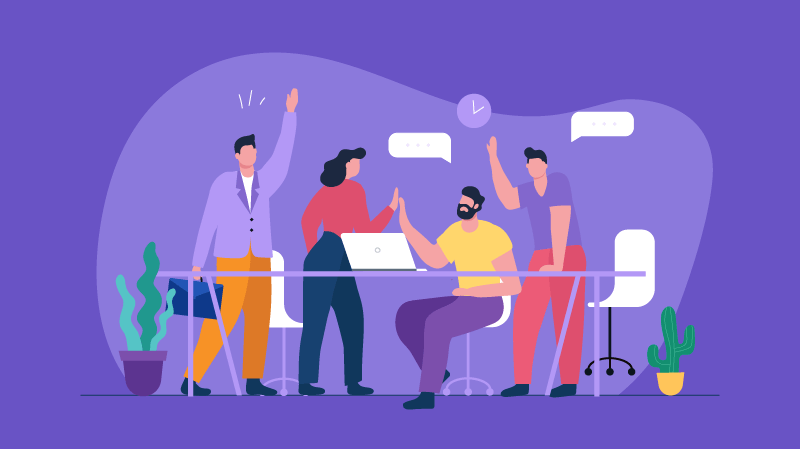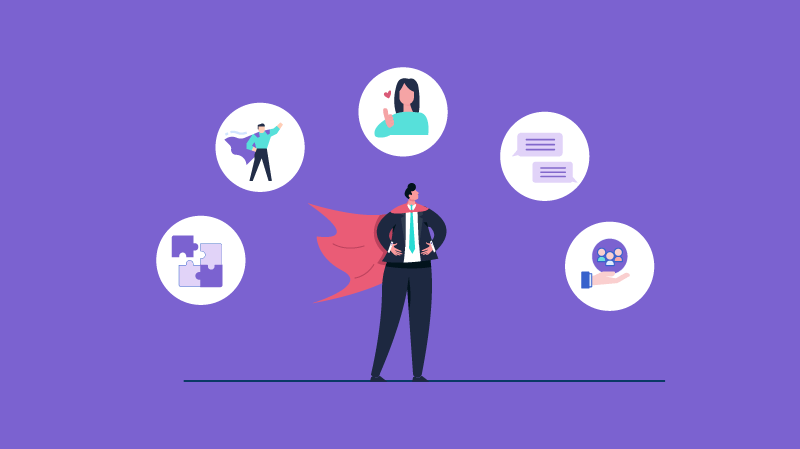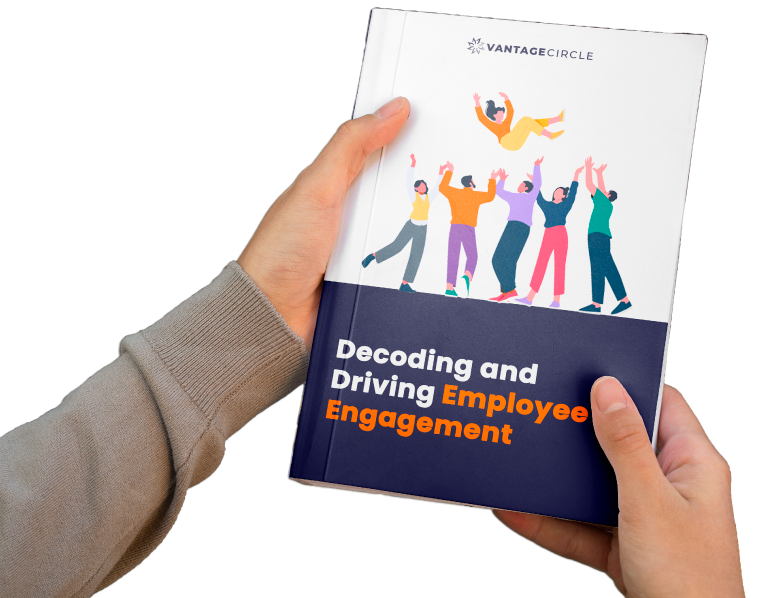Employee Experience: Everything You Need To Know in 2024
In today's competitive talent landscape, organizations are seeking to elevate the entire employee experience to attract and retain top talent. But what happens when your employees struggle to find meaning and purpose at work? You are not alone. Employees everywhere feel disengaged at work.
So, the question you should be asking is what makes a positive employee experience that encourages people to join and stay with the company for a long time?
This article explores employee experience, why it matters, key stages in the employee lifecycle, challenges leaders face in perfecting experiences, and actionable ways HR can cultivate an environment where people thrive.
After reading, you'll have a clear blueprint for crafting employee adventures that inspire staff to bring passion and purpose to move your organization forward.
Key Takeaways
- Concept of Employee Experience
- Importance of Employee Experience
- Stages of Employee Experience
- Challenges of Employee Experience
- Strategies to improve employee Experience and tips to design them
- Leveraging Employee Experience to Boost Customer Experience
- Employee Experience Vs. Employee Engagement
- Types of Employee Experience Surveys
What is Employee Experience?

The employee experience is defined as the cumulative assessment of an employee’s interaction with your company and its people.
– Julian Lute
(Senior strategic advisor at Great Place To Work)
When we talk about "employee experience" or “EX”, we're really talking about everything your people see, do, and come across during their entire journey with your organization.
It's about more than just having great perks or fun team-building events. It's the whole fusion -
- How your culture makes people feel,
- The relationships they build,
- The opportunities they get to learn and grow,
- The motivation they feel to contribute, and so much more.
At its heart, employee experience is about creating an emotional connection between your employees and your workplace. You want them to feel valued, respected, trusted, and genuinely excited to be part of the team.
If you get the employee experience right, your people will feel empowered to do their best work, drive innovation, and deliver great experiences for your customers. This pays off in bigger and better business performance results.
Why Employee Experience Matter?

So far, you have got a gist of employee experience and what defines it. You may wonder why it is important for an organization and how it affects the business.
The simple answer is - employee experience drives real business results. Companies investing in EX significantly outperform competitors on many financial metrics, as well as talent attraction and employee retention.
Specifically, companies focusing on creating a killer EX see hard results on the business side in terms of -
- Faster revenue growth,
- Better innovation,
- Higher profits,
- Glowing customer satisfaction reviews, etc.
On top of that, your employer brand improves when you create an experience where people love to work. Employees become the voice for your company and spread positive words. It helps you attract and retain top talents.
For over 70% of job seekers, the employee experience stands out as a crucial determining factor in their decision-making process, as per a Glassdoor survey.
Why Do HRs Need to Focus on Employee Experience?
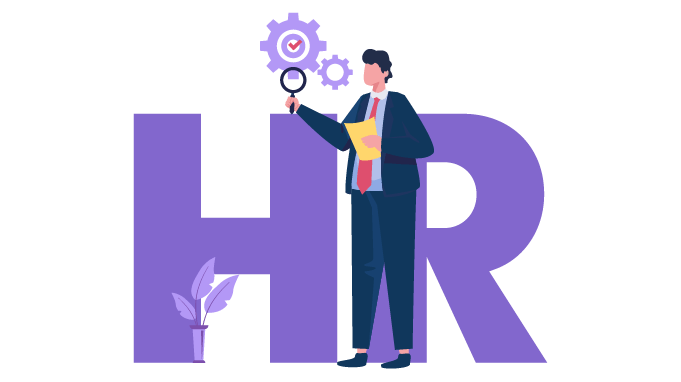
The world of work is changing fast. Many factors have come up that are forcing HR to start focusing on how employees perceive their work.
Let’s discuss some of these factors.
Changing Demographics and Their Expectations

Source: US Bureau of Labor Statistics
New-age employees - millennials and Gen-Zs want to do meaningful work. It has to align with their values and beliefs.
Employees nowadays expect a personalized experience. They want companies to appreciate their uniqueness and provide ample scope for development. The HR team must provide an experience that drives people to do purposeful work.
Rise of Social Media
With social media, employee advocacy is going viral and impacting brand image. Companies are focusing more on their people and their experiences. Because company reviews, whether positive or negative, have the potential to reach millions of people in an instant. If done right, it can be a massive competitive advantage.
Volatile Economy
Pandemics, global disruptions, and increasing digitalization are changing the world of work. Regardless of these shifts, your most valuable asset remains your workforce.
Companies are taking a people-centric approach to HR that correlates with business goals. This helps enterprises sustain even in the toughest times.
Now that we understand the importance, let’s look at the stages of employee experience.
Employee Experience Stages
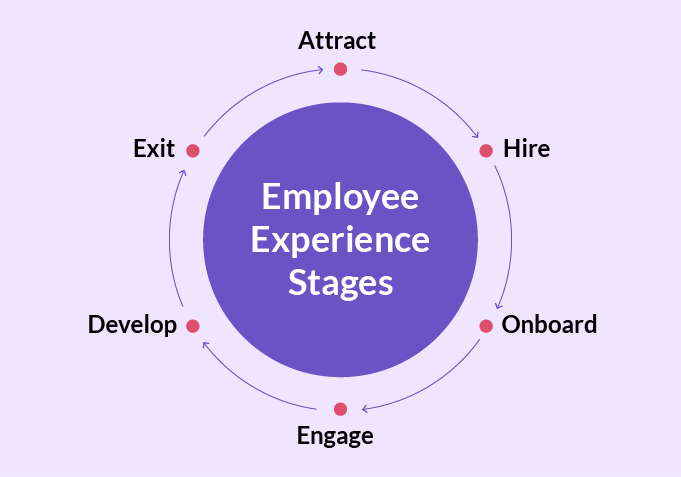
The employee experience spans the entire employee lifecycle across the following key stages:
Attract
This first step involves getting your employer brand out there and promoting openings to build a strong talent pipeline. The goal is to convey what makes your organization stand out to attract qualified candidates.
Hire
Next, you select new team members through an interview process. This process should leave candidates excited to join rather than exhausted. You must ensure applicants have a positive experience during this process.
Onboard
The onboarding stage sets new hires up for success in their roles. Once new hires join, effective onboarding gets them productive quickly by providing the tools, knowledge, and cultural integration.
The main purpose of the onboarding stage is to make people feel welcomed and ready to contribute.
Engage
As employees ramp up, you focus on motivation - developing skills, empowering performance, and fostering an engaging environment that makes people want to excel and stick around.
Develop
Then, it's time to nurture talent by providing ongoing development opportunities for people to grow their abilities and careers over time. This progression is key to retention.
Exit
Even beloved employees eventually leave, whether due to retirement, resignation, or downsizing. Respectful exits preserve relationships. Crucial elements involve understanding reasons people leave and continuing bonds through alumni networks. Tracking who goes out the door and why gives insights into improving existing employee experiences.
Challenges of Employee Experience
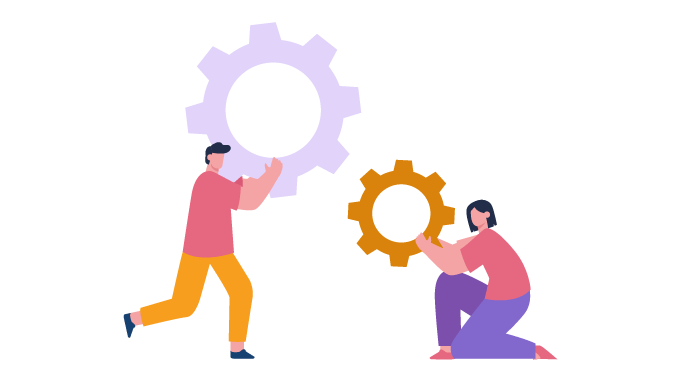
Crafting superior employee experience nowadays is tougher than ever. Between pandemic shakeups, talent wars, and economic rollercoasters, employees expect a lot. Leaders must step up on a bunch of fronts:
1. Instilling Confidence in Uncertain Times
The number one challenge of employee experience is being real about where the company stands amidst uncertainty. Employees seek business health to understand how it might impact their own situation.
This is a very critical scenario for business leaders. They must walk tightropes, acknowledging workforce concerns without fueling deeper uncertainty.
Also, leaders have to maintain engagement during the uncertainty. They can achieve this by -
- Openly communicating about company standings and
- Providing open forums where people can get their outstanding questions answered.
2. Respecting Work-Life Balance
The next challenge is the clash of balance and boundaries between work and personal life among employees. Now that the intensity of quarantine and pandemic work-life is done, employees are seeking healthier, more sustainable work environments.
But there is a slight hiccup. These employee expectations haven’t fully aligned across all organizations and managers.
So, business leaders and managers need to understand their role in helping employees find their work-life balance. Leadership should help teams by -
- Allowing employees to speak up about their needs
- Adopting a hybrid/WFH policy and providing employees the option to work from their preferred location
- Setting guidelines that support both excellent performance and personal well-being.
3. Streamlining Outdated Processes
Nobody wants to wrestle with outdated, bureaucratic processes that overwhelm more than enable. That’s another challenge your employees might face.
It’s the leaders’ responsibility to upgrade the old ways of working and mapping clearer workflows. They can achieve this by -
- Leveraging technology and software to automate manual tasks
- Regularly soliciting user feedback on pain points to increase employee efficiency
These investments show that empowering employees matters to the organization. Additionally, it results in better experience and performance.
4. Connecting Culture and Values
Simply paying your employees for their work is no longer enough. Employees today want to establish a connection between their work and the purpose behind it. The purpose gives them the motivation to thrive in the workplace.
Therefore, organizations must understand and engage with those intrinsic motivations by embedding declared values into actual EX. This requires authenticity from the leaders. Such as -
- Demonstrating personal commitment to inclusion
- Upholding ethically, socially, and environmentally conscious practices
- Leading by example rather than just touting them in an attempt to earn employee trust
7 Ways to Improve Employee Experience
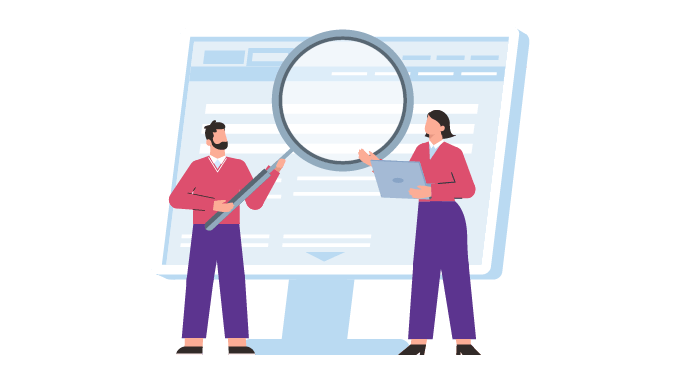
1. Focus on Inclusive Leadership
It is crucial that managers receive training on inclusive leadership behaviors. Studies show that employees are far more engaged and productive when they feel their manager -
- Values diversity,
- Listens openly,
- Seeks their input,
- Advocates for them, and
- Makes them feel comfortable being their authentic selves at work.
Fostering an understanding of diverse perspectives makes employees feel respected and boosts morale. It also contributes to a positive and trusting company culture.
A study by Harvard Business Review found that teams led by inclusive leaders are 17% more likely to report being high-performing.
2. Prioritize Employee Wellbeing
The past few years have worsened workplace mental health issues and have led to increased burnout.
A 2021 Willis Towers Watson research shows 63% of employers now rank enhancing wellbeing programs as a top priority.
When companies offer benefits like mental health services, flexible work options, paid time off, retirement plans, etc, it shows employees that they are cared for as whole human beings.
Additionally, supporting physical and emotional well-being leads to higher engagement and performance, as well as stronger loyalty and retention.
3. Support Hybrid/Remote Workers
The mass shift towards remote and hybrid arrangements means organizations must reevaluate their flexibility.
A 2021 study by E&Y found 22% of employees prefer to work full-time in the office, while 67% of employees believe that their productivity can be accurately measured regardless of their location.
Enabling options with consistency between home and office-based staff is key. There is often a "belonging tax" where remote workers feel disconnected or that they are missing out on in-person interactions or promotions.
Companies need to communicate clearly, host virtual social events, train hybrid managers, and avoid favoring on-site employees to address this divide.
When hybrid/remote policies thoughtfully support inclusiveness and autonomy for these workers, their engagement and productivity rise substantially.
4. Use Pulse Surveys
Regular check-ins through pulse surveys give real-time insight into the EX. But this only works if action plans address the survey findings.
Industry experts recommend brief surveys every quarter or so to measure -
- Satisfaction,
- Feelings of belonging,
- Manager quality,
- Stress levels, and
- Other aspects of the workplace culture.
It is your responsibility to keep the data anonymous, share results, and work on making improvements based directly on the feedback.
You can take advantage of employee pulse survey platforms that can easily accomplish all the tasks mentioned above, including but not limited to anonymous employee feedback.
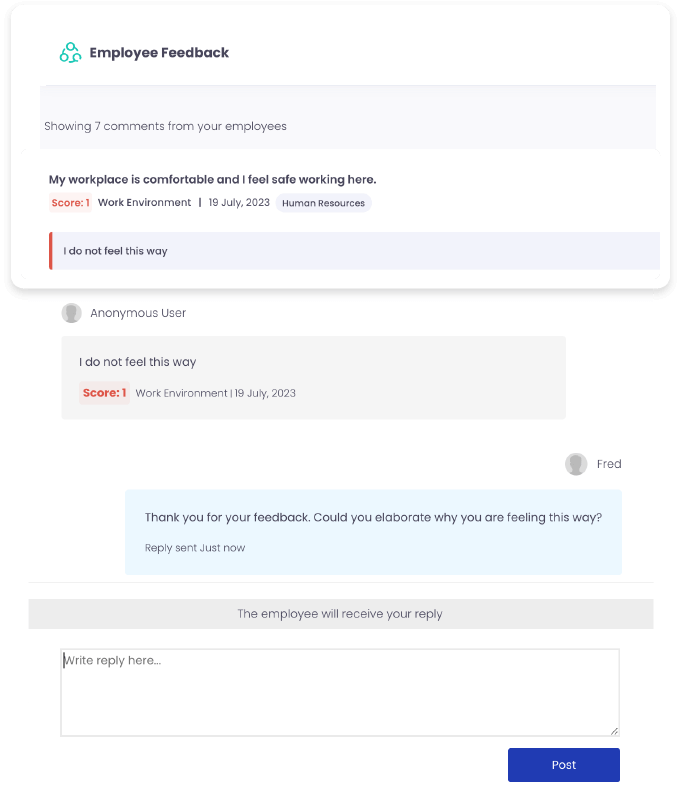
Source: Vantage Pulse
This way, employees will see that their voices influence policies, fostering trust and transparency. Addressing concerns promptly also helps prevent more significant engagement issues.
5. Improve Onboarding
A thorough yet welcoming onboarding experience is critical in the hiring process of an organization. Because an inadequate onboarding can severely impact retention and talent pipeline goals.
The first few months of an employee’s life cycle set the tone of the employment relationship.
This can be achieved by -
- Helping new employees feel supported,
- Providing key context on the organization and role,
- Introducing them socially, and
- Conveying that their contributions matter
Onboarding checklists and buddy systems are useful, as is following up regularly to address expectations or questions. When done right, exceptional onboarding boosts confidence, productivity, and loyalty.
Related: 8 Easy Steps To Build a New Employee Onboarding Process
6. Offer Opportunities for Upskilling and Reskilling
Today's employees strongly value learning and development to stay relevant, grow their careers, and feel engaged in continuous improvement.
Employees expect support from the management in providing development opportunities by creating extensive and well-organized corporate learning ecosystems.
Additionally, you must make it easy for your ambitious employees to navigate the internal mobility paths. This will allow them to gain lateral exposure to other roles without having to quit.
Managers should also support staff in pursuing courses, certifications, and experiences that help them gain new capabilities.
Besides higher retention, offering dynamic upskilling and reskilling opportunities gives employees the skills your organization needs to remain competitive. So it's a worthwhile investment on both sides.
7. Celebrate and Recognize
While paychecks keep employees financially invested, genuine recognition keeps them emotionally invested.
Here are some statistics to give you an idea of the impact of employee recognition -
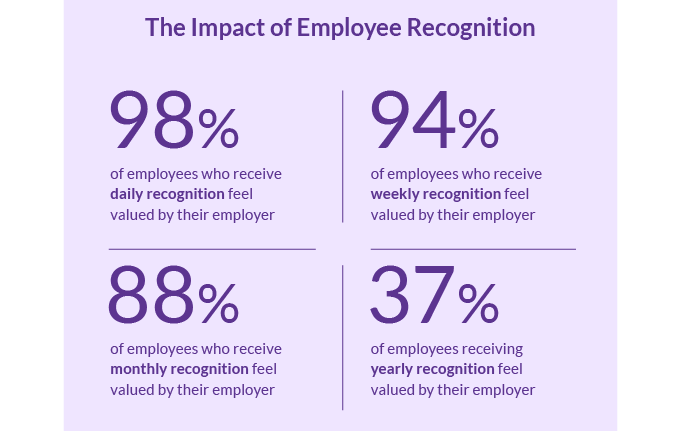
Source: nectarhr
So, what can you do to boost employee experience through recognition?
Here are some ways you can leverage employee recognition to provide positive reinforcement for contributions such as -
- Unexpected rewards,
- Handwritten notes,
- Shoutouts at meetings,
- Appreciative emails from leadership, and
- Celebrating both individual and team milestones is incredibly valuable.
Recognition boosts morale, energizes employees to go the extra mile, and conveys their efforts don’t go unnoticed.
Many organizations have utilized employee rewards and recognition platforms to their full potential to address the abovementioned issues. These platforms allow you to recognize employees for their contributions regularly. This leads to higher engagement and performance over time.
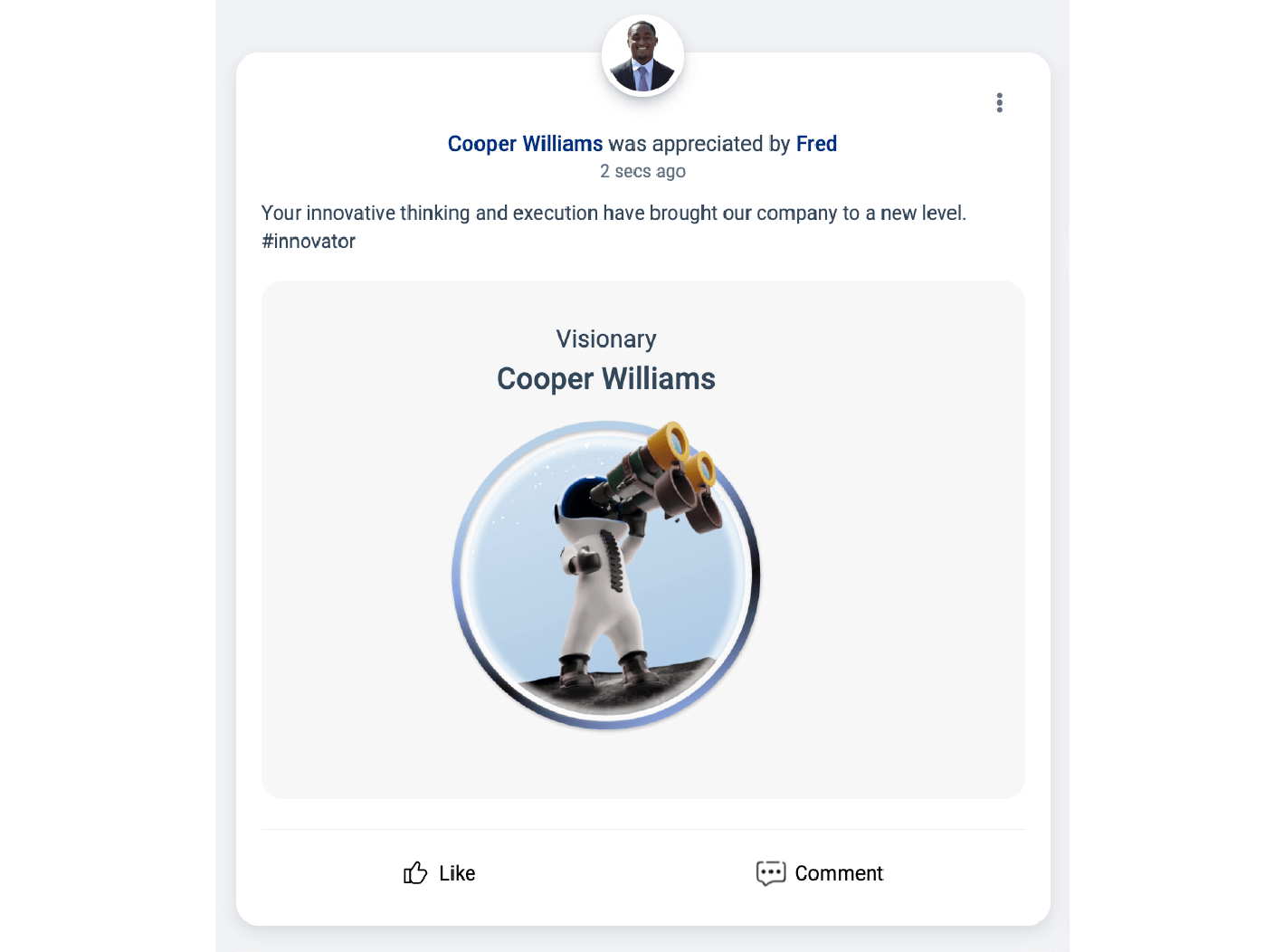
Source: Vantage Rewards
How To Design An Employee Experience Strategy?
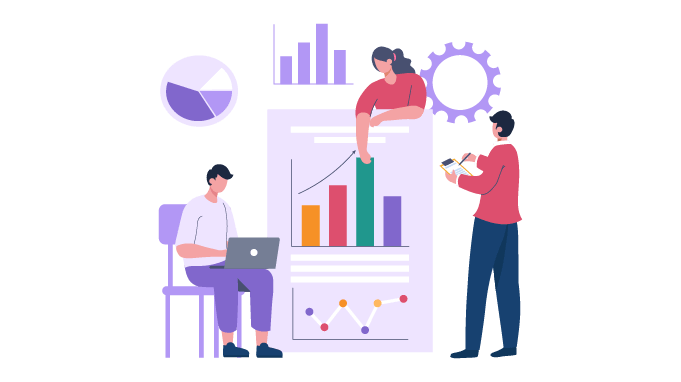
An organization is a lot like a sports team - everyone needs to work together seamlessly to score points and get results. And just as a coach draws up strategic plays to bring out the best in athletes, company leaders need a thoughtfully orchestrated employee experience strategy. This game plan should motivate and support employees to put their unique talents to work.
To design a meaningful experience for employees, HR needs to embrace flexibility and change in their EX strategy. The following things should be kept in mind:
- Set the priority of your strategy. If you want to decrease turnover, work on understanding the trigger points. You might want to improve the exit experience.
- If your company is hiring, you might want to focus on the recruitment and onboarding experience. Determine your priority and put renewed focus on it.
- Help create a personalized experience by taking regular feedback from employees.
- Work on the gathered data to find linkages and patterns that are working and that need improvement.
- Culture, technology, and working environment need to be optimized to suit individuals and teams.
- Diversify your HR functions to include everything that impacts experience, like customer experience, strategic decision-making, leadership, etc.
Here are 7 steps for you to design the best employee experience strategy -
1. Define Objectives and Outcomes:
The first thing you need to do is rally leadership together to get crystal clear on what success looks like. What do you want to achieve through this strategy -
- Bigger engagement?
- Higher retention?
- Becoming a top talent hotspot?
You need to clearly outline the objectives of your employee experience strategy. Understand what outcomes you aim to achieve, such as improved employee satisfaction, increased productivity, and enhanced organizational culture.
Having a clear vision of the end goal will guide decisions and investments, ensuring successful achievements on your key performance markers.
2. Conduct Employee Research:
So, you have defined your objectives and end goals. It’s time for you to take the next step. You must really tune in to what matters to employees. Gather insights through -
- Engagement surveys,
- Focus groups, and
- One-on-one interviews.
This will help you understand employee expectations, pain points, and aspirations. This information forms the foundation for your strategy.
3. Map Employee Journey:
Once your research is completed and you have heard your employee’s voice, proceed to the next step in the process. With a clear picture of your talent, outline the main stretches of their journey. Identify key touchpoints in the employee lifecycle, from recruitment to offboarding, including but not limited to -
- Exploring job opportunities,
- Choosing roles, and
- Navigating the initial period of employment to professional growth stages
Analyze each phase to ensure a seamless and positive experience.
Additionally, highlight key milestones like probation closing, promotions, and service anniversaries. And identify transition points that need attention to prevent exits.
4. Create a Positive Work Environment:
Merely analyzing the employee journey is not enough to create a positive experience. You must step in to cultivate a culture that promotes collaboration, inclusivity, and well-being. You can achieve this by -
- Fostering open communication,
- Providing opportunities for professional growth, and
- Recognizing and rewarding achievements.
Additionally, ensure traditions like peer-to-peer recognition and wellness initiatives are woven in to energize and inspire employees to bring their A-game daily.
5. Personalize the Adventures:
Once you create a positive environment for the workplace, you should look into personalizing the experience to make it an adventurous ride.
Avoid sticking to conventional approaches that may not effectively utilize new talent. You can do it by creating “employee personas" based on generations, roles, and styles to guide experiences that address employees’ specific priorities.
For example, Gen Z employees might expect mentors, while tenured managers may require upskilling. Tailoring your approaches will result in positive results.
6. Measure and Analyze Metrics:
So far, you have done everything right. You have defined your objectives, done research, and created the best environment to boost employee experience.
But how do you measure your success?
By establishing clear metrics.
You must establish key performance indicators (KPIs) to measure the success of your EX strategy.
Establish clear metrics like -
- Retention rates,
- Engagement survey results,
- Productivity scores and
- Promotion percentages
These will signal if your employee experience hits the mark or misses key attractions. Additionally, you should regularly gather quantitative and qualitative feedback to discern what’s working and what needs improvement.
7. Reiterate and Improve:
As you figure out which part of the strategy needs improvement, you must take this final step into consideration.
Also, you need to keep in mind that employee needs and expectations evolve along with the changes in the industry landscape. This calls for the need for -
- Regularly revisiting and updating your employee experience strategy
- Seeking feedback and being agile in making improvements
- Continually connecting with your employees to assess enhancements that embolden individuals and the whole team
Involving your employees in this process will encourage them to elevate their efforts, knowing leaders listen and care to provide a better experience in their ongoing journey.
Leveraging Employee Experience to Boost Customer Experience
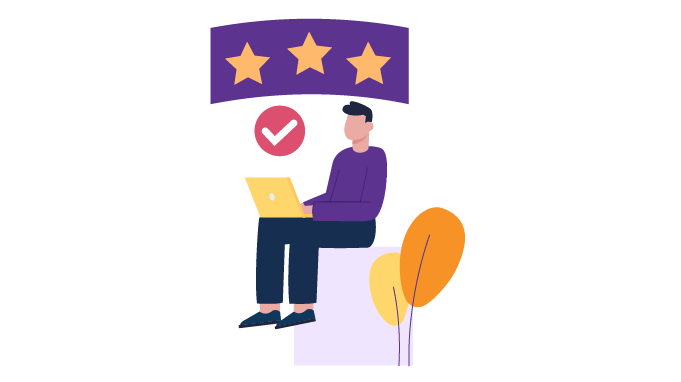
If you run a business, you understand the importance of customer experience.
Your customers drive your business. But who drives these customers towards your business?
Your employees.
Employees are a company’s most important asset. They interact and deal with customers and are entrusted with delivering a positive customer experience. So, how you treat your employees has a direct impact on your customer experience.
Employees' level of engagement defines their ability to attend to customers' problems. When employees get a good experience, they engage more in their work. They are enthusiastic about solving customer problems. This can have a direct impact on retaining customers, building brand value, and outperforming competitors.
However, a poor employee experience can lead to disengagement. It affects performance, absenteeism, and ravages customer experience.
Impact of Employee Experience on Customer Experience
- Engaged employees provide better and hassle-free customer service.
- They are most often enthusiastic and confident, so they want to solve customer issues.
- Engaged employees bring positive energy to customer interaction. They listen and attend to customers' concerns, be more respectful, and treat them well.
- It decreases unhappy customers and improves service ratings and positive feedback.
- If customers are happy with your services, they are more likely to become loyal customers.
- A company that prioritizes its employees creates a positive brand value.
We can see how customer experience and employee experience depend on each other. However, companies focus only on improving customer experience to increase their ROI.
80% of businesses compete primarily on customer experience. They forget about their employees and do not do enough to create a great experience for the employees.
Without improving employee experience, efforts to ensure a great customer experience won't work. Because when employees have an unpleasant work experience, the customers suffer, too. And so suffers the company's ROI.
Clients do not come first. Employees come first. If you take care of your employees, they will take care of the clients.
– Sir Richard Branson
So, your employees' experience becomes just as important as your customers'. Both need to go hand-in-hand for better business results.
A satisfying customer experience begins with providing a meaningful employee experience. In other words, the first step to customer satisfaction is employee satisfaction.
Employee Experience Vs. Employee Engagement
| Employee Experience | Employee Engagement |
|---|---|
| Employee experience is the input on the employer’s part. It involves applying various methods by employers to elevate EX. | Employee engagement is the output that comes after elevating EX. In simple terms, better EX leads to higher engagement. |
| It is a bottom-up concept. It involves everything that your employees go through at work. It’s about making their experience better. | It is a top-down philosophy. It is about valuing your employees to keep them motivated for better results in the long term. |
| Focuses on the worker as an individual. | Focuses on the workplace and employee productivity. |
Recommended Read: Employee Engagement: Creating A Engaging Work Culture
Types of Employee Experience Surveys
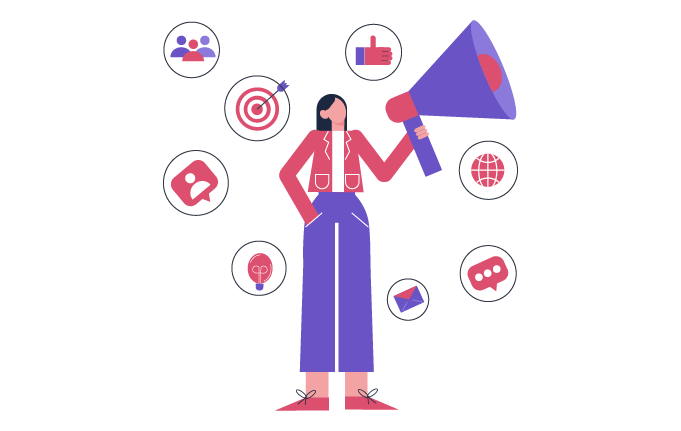
Surveys serve as valuable check-ins to gauge the health of your organization's employee experience, similar to routine check-ups assessing wellness needs.
However, not all diagnostics are equal. Targeted questionnaires aligned with different stages of the employee journey provide precise insights to address specific areas.
Let's explore six essential surveys.
1. Candidate Attraction Surveys
Kick things off with candidate surveys to capture newcomers’ impressions during recruitment interactions.
Understanding candidates’ perceptions of your employer's brand and recruitment process is invaluable. Distribute brief surveys to job applicants asking about the following:
- Overall experience with the hiring team
- Effectiveness of communications
- Areas of strengths/improvement
This talent acquisition feedback shapes future hiring approaches to bolster sourcing and ensure candidates have a positive first impression.
2. New Hire Onboarding Surveys
Check-in with recently onboarded employees around the 30/60/90 day marks via surveys or interviews asking:
- Clarity of role expectations
- Helpfulness of training
- Manager relationship dynamics
- Areas still needing support
Onboarding survey results indicate how well you are welcoming and preparing new hires to contribute value. Use findings to fine-tune transitions and better set early career trajectories.
3. Annual Employee Engagement Surveys
In-depth annual surveys evaluate all facets of the workplace experience, including:
- Sentiment about culture, leadership, inclusion
- Access to resources, autonomy
- Career development and performance
- Manager dynamic and teamwork
Broad annual surveys benchmark engagement levels to inform experience upgrades across the employee life cycle. Anonymity elicits candor to shape human capital strategies.
4. Pulse Surveys
Brief, real-time pulse surveys help take the organization’s temperature by asking for fast feedback on timely topics like:
- New policy rollouts
- Current issues or events
- Input on decisions
- Work environment needs
Continual pulse surveys foster dynamic listening to address emerging needs in an agile way before small problems balloon.
5. Exit Surveys
Departing employee exit surveys reveal “should have known” insights by exploring:
- Primary drivers of resignation
- Aspects employees will miss
- Areas leadership should improve
- Likelihood to recommend your company
Exit interview findings pinpoint experience gaps that may be pushing talent out the door so you can patch turnover triggers.
6. 360 Degree Feedback Surveys
The 360 degree survey includes feedback from an employee’s peers, direct reports, and manager to assess:
- Leadership competencies
- Collaborative abilities
- Workstyle strengths/development needs
- Overall performance
360 feedback furnishes well-rounded visibility into skills and behavioral gaps to coach leaders in enhancing team member experiences.
Final Words
The bottom line is that good employee experience directly fuels business success. Employees who feel energized, included and supported invest extra effort to deliver exceptional results.
While paychecks provide baseline incentives and perks add nice touches, it's ultimately experiences touching hearts and minds that elicit full engagement and performance.
By embracing empathy, agility, and authenticity around understanding employees’ emotional connections to the workplace, leaders can thoughtfully curate adventures that help every person shine.
This pays dividends through better retention, innovation, productivity, and customer experiences. Companies investing in experiential excellence will surely gain a competitive advantage in both winning and keeping today’s purpose-driven talent.










